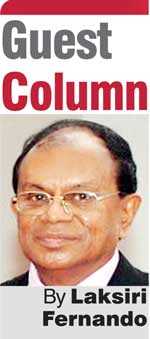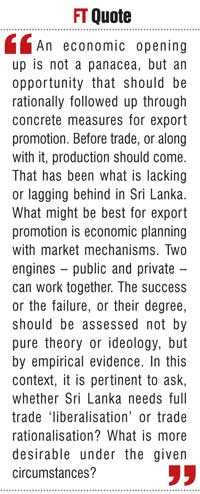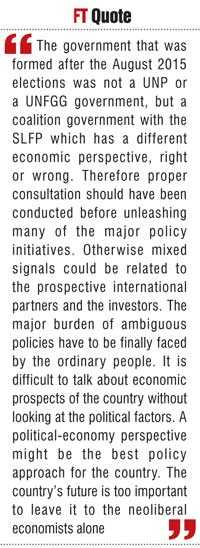Thursday Nov 13, 2025
Thursday Nov 13, 2025
Friday, 26 October 2018 00:01 - - {{hitsCtrl.values.hits}}

A fundamental defect in the economy in Sri Lanka is the neglected agricultural sector where nearly 30% of the population are dependent, but the contribution to the GDP is less than 10%. This is also one reason for the low government revenue, which is a cornerstone of budget deficits. Food industry has to be promoted, and processed and natural food exports can be a lucrative industry – Pic by Shehan Gunasekara
 Trade liberalisation or free trade has come to a sharp controversy in the context of recent and ongoing rupee depreciation. However, it has been thoroughly a discussed topic internationally, both theoretically and empirically, although not conclusively.
Trade liberalisation or free trade has come to a sharp controversy in the context of recent and ongoing rupee depreciation. However, it has been thoroughly a discussed topic internationally, both theoretically and empirically, although not conclusively.
There is a school of thought closer to the economic decision making in Sri Lanka quite surprisingly argues that the country’s rupee depreciation and related economic ailments like the adverse balance of payment, sluggish export growth, low influx of FDI and the depressed economic growth are due to the absence or non-implementation of a full scale liberalisation policy. They want to see everything in one basket.
There are critics on the other hand who point out that the reckless free trade agreements, excessively liberal BOI conditions, non-monitoring of external trade and recent liberalisation of para-tariffs are the primary reasons for the above predicaments in addition to long term and external factors.
There is an unfortunate possibility of Sri Lanka now going from excessive liberalisation to excessive protectionism, under the rupee depreciation and foreign exchange difficulties.
From one policy to the other
‘Open economy’ was the earlier term for trade liberalisation particularly in our country. Complete closed economies or complete open economies have never existed, and never will be. Since independence, Sri Lanka has experienced the economy going from one direction to the other, without forging at least a broadly agreed national policy or model by different governments and schools of thought. The reasons can be both national and international compulsions.
Peter Watson traces the long-distance trade from circa 150,000 years ago, but the Sri Lankan chronicles talk about Thapassu and Bhalluka, two merchant brothers, who apparently traded between Bharata and Lanka, apart from their role in the spread of Buddhism, 250,000 years ago.
At independence, Sri Lanka inherited an open export economy of peripheral nature which naturally encountered balance of payment difficulties as the time passed by. That is why when Donald Snodgrass wrote his exploration of the Sri Lankan economy in 1966, he titled it as ‘Ceylon: An Export Economy in Transition.’
Balance of payment difficulties was a major reason why the country opted to implement import substitution policies in addition to ideological preferences. Sri Lanka was pushed for extremely closed policies in early 1970s, not necessarily by choice, but rather under compelling circumstances.
It was under an evolving new international division of labour (NIDL) that the country could open up the economy again since 1977, yet at a cautious pace. The experience in many East and East-Asian countries has also shown that when a country is ‘opened up’ for trade without neglecting the other sectors (i.e. agriculture, public sector, small business, manufacturing for the local market, etc.), economic growth could take off. Another necessary element is state monitoring or intervention (not control). That is what we can call a balanced and a rational economic policy.
What is desirable?
An economic opening up is not a panacea, but an opportunity that should be rationally followed up through concrete measures for export promotion. Before trade, or along with it, production should come. That has been what is lacking or lagging behind in Sri Lanka. What might be best for export promotion is economic planning with market mechanisms. Two engines – public and private – can work together. The success or the failure, or their degree, should be assessed not by pure theory or ideology, but by empirical evidence.
In this context, it is pertinent to ask, whether Sri Lanka needs full trade ‘liberalisation’ or trade rationalisation? What is more desirable under the given circumstances?
Trade rationalisation could encompass a certain degree of liberalisation, but not fully. Trade rationalisation requires a clear (sophisticated) state intervention and monitoring. Apart from the balance of payment, the trade deficit has to be closely monitored and the currency rate should be kept within a reasonable range. In order to promote exports, concessions can be given, but not of exorbitant nature.
The tariff system should be simplified by abolishing the cumbersome tariffs such as para-tariffs, and having a standard tariff rate/s, which could be increased or decreased given the circumstances (not haphazardly). Even the shipping procedures could be streamlined however with agreement of the local agencies. Shipping industry is an area that can be developed exponentially, given Sri Lanka’s favourable location.
Lessons from the first phase
 When trade ‘liberalisation’ was introduced in 1977 in the name of an open economy, there was a rationale. People were fed up with scarcity, food controls, rice barriers (harl polu), long queues to obtain provisions, etc. Foreign exchange controls affected many who wanted to pursue postgraduate studies abroad or travel overseas. The business community was fed up with import-export controls, politically/ethnically tainted import-export licence system, lack of investment goods, capital funds, etc. Therefore a major change was necessary.
When trade ‘liberalisation’ was introduced in 1977 in the name of an open economy, there was a rationale. People were fed up with scarcity, food controls, rice barriers (harl polu), long queues to obtain provisions, etc. Foreign exchange controls affected many who wanted to pursue postgraduate studies abroad or travel overseas. The business community was fed up with import-export controls, politically/ethnically tainted import-export licence system, lack of investment goods, capital funds, etc. Therefore a major change was necessary.
Did the open economy of 1977 succeed? Yes, to a great extent, but not fully. Perhaps what prevented a major transformation was the internal political conditions, particularly the civil wars in the North as well as in the South. On the other hand, these conditions were propelled by the open economy itself, according to some research findings (Newton Gunasinghe).
Haphazard liberalisation of external trade largely ignited ethnic frictions which led to the July 1983 riots against the Tamils. Import liberalisation also affected the peasants both in the North and the South, the younger generations becoming the backbone of the insurgency movements (LTTE and JVP). When R. Premadasa was trying to strike a balance in the open economic policy with social welfare measures, it was rather too late.
The rest is history, but the lesson is clear that major ‘liberalisation’ efforts should not be undertaken unless the policies are balanced, rational, incremental, and implemented with the people’s consent, or otherwise there could be political backlashes. Even at present, the liberalised trade sector has created frictions between the Sinhalese and the Muslims.
As I write this article, there is this news from the World Bank arrogantly announcing “Ageing population makes Sri Lanka’s welfare programs unaffordable”. The apparent advice is clear. It might not be the whole World Bank who is responsible, but a small group of neoliberals who have gathered around the Sri Lanka programme to dictate terms and experiment their theories.
No clear mandate for liberalisation
When the UNFGG, led by the UNP, put forward its manifesto before the August 2015 elections, it proclaimed a strategy to ‘strengthen the economy’ but not about liberalising it. There were 16 points in it, but none of them talked about ‘liberalisation’ in that sense, apart from saying ‘strengthening Sri Lanka’s position in the international market.’
It is true that the UNP has always been having a more liberalised economic policy, but what they talked about at the elections was a ‘social market economy’ and not liberal market economy. Now that talk has been terminated for the sake of mere liberalisation.
The government that was formed after the August 2015 elections was not a UNP or a UNFGG government, but a coalition government with the SLFP which has a different economic perspective, right or wrong. Therefore proper consultation should have been conducted before unleashing many of the major policy initiatives. Otherwise mixed signals could be related to the prospective international partners and the investors.
The major burden of ambiguous policies have to be finally faced by the ordinary people. It is difficult to talk about economic prospects of the country without looking at the political factors. A political-economy perspective might be the best policy approach for the country. The country’s future is too important to leave it to the neoliberal economists alone.
Current ambiguous phase of the open economy
 The current phase of the open economic policies did not start with the new government in 2015. It started with the political change in 1994 which declared an ‘open economy with a human face.’
The current phase of the open economic policies did not start with the new government in 2015. It started with the political change in 1994 which declared an ‘open economy with a human face.’
It meant the preservation and promotion of the social security and welfare framework along with the public sector initiatives. This is what continued in the country until recently, whatever the mistakes or blunders. What was dreadful during the last phase of the new phase was corruption, nepotism and waste which are unfortunately unabated under the present dispensation.
In addition, the UNP wing of the government had unleashed a neoliberal policy quite bureaucratically in several areas, and two can be highlighted as follows.
(1) Following some of the old recommendations of the WTO and others, the government first tried to introduce a cash grant instead of fertiliser subsidy as a measure of artificial marketisation of the agricultural economy. But it was a dismal failure without any pilot studies, proper preparation or people’s support.
(2) A similar policy still in the offing is to give vouchers instead of school uniforms to school children following some American neoliberal experiments in ‘charter schools.’ Even in this policy implementation, there was no pilot study, proper research or education for the people to perhaps appreciate the market mechanisms.
Free trade is not a bad idea if it is implemented properly and gradually. Not only the middle class but also the working people can benefit as advocated by Henry George (‘Protection or Free Trade,’ 1886). However the primary concern should be the people and their wellbeing.
Import side of free trade is easy, but the difficult side is exports. Sloganeering per se cannot promote exports. Before exports, there should be production and industries. This is what is lagging in Sri Lanka and the present government and the previous one have not done much to improve the situation. It is insane to talk about new free trade initiatives or agreements within an unfavourable international atmosphere as at present. What should be prioritise is the consolidation of the national economy.
Some conclusions
Trade liberalisation has been going on in Sri Lanka well before India since 1977, of course with ups and downs. However, the country has not yet been transformed into an export oriented economy. Considering the continuing large disparity between imports and exports, it is fair to consider Sri Lanka as an ‘import economy’ than an export economy.
Of course, if tourism is named as an export industry, the situation or the picture might improve. What is necessary however is not a cosmetic change but the promotion of tourism as a key industry in the country. Even for this purpose, certain internal conditions should improve like transport, banking facilities, tourist attractions, people’s acceptance, etc. Switzerland is a country which became a developed economy mainly through tourism and banking. To develop the tourist industry to new heights, the country may need its own Belt and Road and also Air initiative (BRAI).
The failure to transform Sri Lanka has been basically due to the mistaken priorities and the contradictions in economic fundamentals. Liberal imports can and have expanded the retail trade, but with adverse effects as we have discussed. Trade deficits are not something that a country can ignore in the long run. Vietnam also faced trade deficits when the country was opened up first, but as the national economy was on a good footing, soon the situation changed, and the exports took off.
A fundamental defect in the economy in Sri Lanka is the neglected agricultural sector where nearly 30% of the population are dependent, but the contribution to the GDP is less than 10%. This is also one reason for the low government revenue, which is a cornerstone of budget deficits. Food industry has to be promoted, and processed and natural food exports can be a lucrative industry. Considering all these requirements of restructuring and public policy initiatives, rationalisation is the correct approach instead of mere liberalisation.